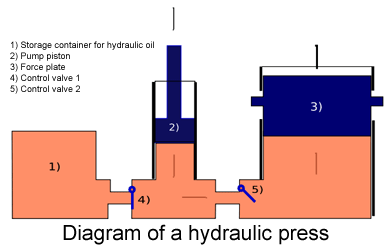
|
As manufacturers are keenly aware, the mechanical components of a hydraulic system must be very stable and able to withstand considerable pressure to avoid a leaking connection, resulting in a sudden loss of hydraulic fluid and rendering a machine inoperable from extensive contamination. Leak testing helps ensure the soundness of a hydraulic system. Comprehensive leak testing of all components - tubes, hoses, pressure tanks, compressors, etc. - and any assembled hydraulic machine prior to being filled with hydraulic fluid is crucial. Once the hydraulic oil is in the system, any compromised component or leaky connection can result in the loss of a large amount of the fluid. Any subsequent leak testing (using a gas) becomes even more difficult, as small leaks can be temporarily plugged by residual oil, which can lead to leaks later on. Helium leak testing is a simple and environmentally safe method to test for leaks. The pressure system (or specific parts) are evacuated and filled with helium or a helium-gas mixture at excess pressure. A helium sniffer then checks all critical points to detect any emerging test gas, which is fed to the leak detector. The detector unit calibrates the amount of measured gas, resulting in a precise estimate of the size of the leak. Taking the operation pressure into account, the leak size estimate is converted directly to the amount of hydraulic fluid that can potentially be lost. This leak test method is used when any loss of fluid could lead to environmental pollution or equipment downtime. The range of test applications includes all applications for hydraulic technology, including:
Further include elevators, forestry equipment, roller mills, mining equipment, and all jobs that need to move heavy loads. Click here to learn more about INFICON helium leak detectors »
|
| Forward
to a Colleague Subscribe | Contact Us | Visit INFICON Fall 2008 |
||||||

|
 |
 |
Leak
detection has many faces in many places. We are looking for your best
leak detection photo. Send
us a photo of you and/or your team in action with your
INFICON leak detector, and you get a cool gift! |
| INFICON GmbH Leak Detection Tools Business Unit (LDT) Represented by managing director: Dr. Ulrich Döbler Bonner Strasse 498, D-50968 Köln, Germany |
Registered Office: Cologne Commercial Register: Local Court Cologne: HRB-Nr. 26659 VAT identification number: DE205 480 919 Ticona Information Service Tel: +49.(0)221.347.40 (Germany) Fax: +49.221.347.342414 (Germany) email: Yvonne.Eckseler@INFICON.com |
| © INFICON | |
